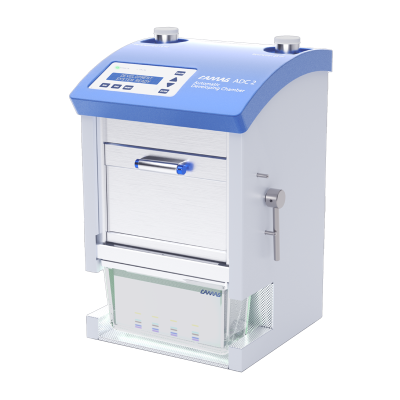
CAMAG®
AMD 2 System

In a nutshell
high resolution, precision, and repeatability
The separation of complex samples is a challenging task for every chromatographic system, particularly when the sample components span a wide polarity range.
The AMD procedure offers an excellent solution as it allows stepwise gradient elution over increasing separation distances. As a result acids, bases, neutral, hydrophilic, and lipophilic substances can be separated in a single AMD run. This makes AMD suitable for a variety of applications.
The technique is frequently used in lipid analysis and in routine analysis of drinking water. Pigment formulations with a complex composition, resins as well as additives of mineral oil products are other typical applications of AMD analysis.
-
Automated multiple development
-
Stepwise gradient elution over increasing separation distances
-
Enhanced separation capacity
-
HPTLC glass plates (20 x 10 cm), only
-
Software-controlled with visionCATS
THE PRINCIPLE OF
THE AMD PROCEDURE
- The HPTLC plate is developed repeatedly in the same direction
- Each successive run extends over a longer solvent migration distance than the one before
- Between runs, the solvent is completely removed from the developing chamber and the layer is dried under vacuum
- Each successive run uses a solvent of lower elution strength than that of the one used before. In this way, a stepwise elution gradient is formed
- The combination of focusing effect and gradient elution results in extremely narrow bands. Their typical peak width is about 1mm. This means that, with the available separation distance of 80mm, up to 40 components can be completely resolved, i.e with base line separation
- With visionCATS the AMD 2 can be IQ/OQ qualified and used in a cGMP environment. Operated with the mentioned software, the AMD 2 supports compliance with 21 CFR Part 11.
The AMD 2, like other software-controlled CAMAG instruments, communicates with visionCATS. The gradient, made from up to 5 solvent bottles, is defined by input into a table in visionCATS. Gradient and solvent migration distance for each run can be shown graphically for verification. Then all individual runs of the developing program are performed fully automatic and monitored by visionCATS.
SEPARATION OF VARIOUS
RHUBARB SAMPLES BY AMD 2
HPTLC chromatogram of rhubarb under UV 366 nm, derivatized with Natural Product reagent; AMD gradient in 10 steps: methanol – dichloromethane (40:60) to (10:90) in 9 steps, 40 mm solvent migration distance, then one isocratic step methanol – dichloromethane (10:90) over 70 mm solvent migration distance

Technical specifications
-
Plate typesTLC/HPTLC glass plates 20 x 10 cm
Glass thickness 1 mm
Layer thickness up to 250 µm -
Nitrogen or clean air pressure4.5–6 bar (60–90 PSI)
-
Nitrogen consumptionApprox. 1 L / gradient step
-
Gas volume of chamberApprox. 550 mL
-
Environment temperature15° – 30° C
-
Solvent front detectionCCD, accuracy better than ± 1mm
-
Number of developing stepsMax. 99
-
Power connection100 V–240 V; 50/60 Hz
-
Dimensions (W x D x H)430 x 500 x 360 mm (550 mm incl. bottles)
-
Weight31 kg
What you need to get started
Ordering Information
-
022.8860
CAMAG® AMD 2 System Automated Multiple Development
Chromatogram developing module, accessories include all electrical and pneumatic connecting elements, supply of sealing materials, HPTLC plate positioning device and small ancillaries, RS 232, auto-range power supply (100–240V)
-
022.8880
Oil-sealed rotary vane vacuum pump RV3
including gas ballast/oil return, oil vapor filter, flexible vacuum hose 1 m, ready to connect to the CAMAG AMD 2 System, 100–120 V or 220–240 V
-
028.0000
CAMAG® HPTLC Software visionCATS: Basic Version
including access and control of all instruments – 1 server, 1 client Instrument Diagnostics (xQ), analytical reports – access to method library. Needs to be purchased separately and is not included in any Ultimate Package.
Interested in the product?
Reach out to your local distributor and enjoy faster, improved results at reduced costs.









